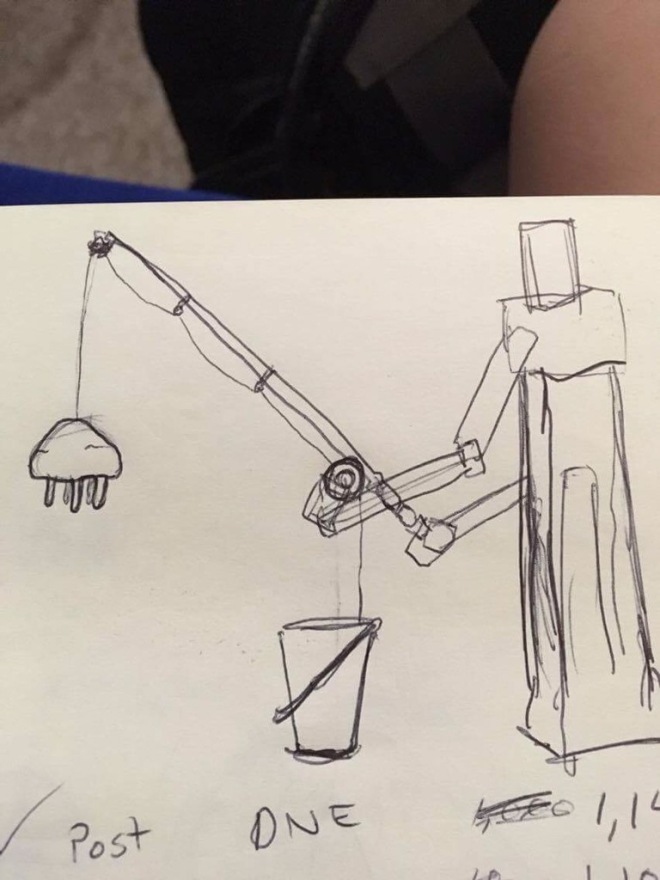Editing for Maximum Effect
Dialogue Choices
Thought I’d write up a quick lesson for people keen to get into video editing. This one’s about editing dialogue, particularly how to get the most out of your dialogue. We’ll start with this example, where you have to decide between two pieces of dialogue which leave the same impression:
- Daughter: Can I get a birthday cake from the Michelle’s Patisserie?
Mother: You can have one from Coles. - Daughter: What am I giving Stacy for her birthday?
Mother: Can’t you just make her something, or draw her a card?
Both examples tell the audience the characters don’t have a lot of money, however the second example also gives us more information about Mother and Daughter. Embedded in the dialogue we see that “what am I giving…” insinuates that the protagonist had expected Mother had bought Stacy’s birthday present. Mother’s response emphasises that their family doesn’t have much money whilst also dismissing the expectations Daughter has of her.
The original character of Daughter in this example called for a Varuca Salt-like performance. A girl with a snobbish attitude, and who is prone to telling tall tails. She tells lies to impress her friends. The Actress had chosen to interpret the role with a slight twist, adding a highly charged energy, still keeping the attitude of the character. Possibly due to a lack of skill, in the editing room footage her lies look unbelievable. The lies appear suspicious and over-the-top. It’s funny.
Editing according to the original character as written in the script can sometimes make the actor’s performance of the character seem unnatural. If that actor has decided to read an originally mono-tonal line as exaggerated and over-the-top, deviating from the scripted meaning, as an editor ask yourself: what has the actor done with the character, because that is who the character is now.
Week 14. Jellyfish Petting Zoo
The jellyfish is known as a weed species. In the last two decades jellyfish have grown in size and number. This is mostly due to the rise sea temperatures. This invasive creature thrives in the heat whereas other ocean live and coral does not.

Petting zoos can be described as a ‘meeting place’ for different species and humans. For this petting zoo we have designed Moon Jellyfish.
Because this work is about the relationship between jellyfish and the temperature of the water they inhabit so the fabric used to make the sculptures is warm to the touch. Normally, you would find jellyfish in an aquarium but, because of their position in this installation, the role is reversed as the jellyfish play the part of the humans visiting the petting zoo. Positioned above.
They shock by dropping down onto the audience; they’re just trying to pat you! The work’s movement has been inspired by William Forsythe’s large pendulum installation, ‘Nowhere and Everywhere at the Same Time’ (2016) and the jellyfish aesthetic of Ken Rinaldo’s interactive robot sculpture series, ‘Autopoiesis’ (2005).
Week 13
Blooms!
On a global scale, jellyfish populations in coastal marine ecosystems exhibit increasing trends of abundance. High-density outbreaks may directly or indirectly negatively affect human economic and recreational activities, as well as public health through impacts on tourism, fisheries, industry and local wildlife.
A Biomass!
If harvested the abundance of jellyfish could be a valuable source of bioactive compounds beneficial for cosmetic, medicinal and food industries; bioactive peptides, collagen and gelatine, fatty acids, enzymes, calcium, water-soluble minerals, and biopolymers.




Week 12
South west island of Vietnam Bai Sao jelly fish
Week 10 & 11. Jelly Fish Poetic Aesthetic
Language
A language divide in this work brings a tension that, only recently have i noticed, has helped to shape this work.between Zoe and I the word ‘Jelly Fish’ poetically lends itself to different interpretations . The ‘con’ of not being able to communicate with a great deal of spoken language becomes a ‘pro’. Zoe is making her Jelly Fish with a plush doll aesthetic using her skills in teddy bear making. 
Beyond Empathy Post Eight (Final)
Blog Description:
These Beyond Empathy blog posts document my internship with the not-for-profit organisation Beyond Empathy (BE). BE works in the community: making art and fighting social disadvantage. You can see the previous post here, and the first post here.
Here is a link to some of the media coverage, an article the Illawarra Mercury newspaper published Here. You can also keep updated on Blue Rose events by following this link.
Blue Rose Show Reflection:
Whilst interning with Beyond Empathy I had full support and mentorship. I gained a lot from observing the type of hands-on work BE employs. When required, the role let me apply developing practical skills formed over years of study and social life. I relished the challenge to use these practical skills, though found they needed improvement.
A vital lesson learnt from my time with BE was to be prepared. You cannot know everything or predict the outcomes of an event so it is best to put in place contingencies and be flexible when needed. The ‘Water Space’ for example was excluded days before the event due to time and people-power constraints.
As an intern my role was to assist with the current project, the ‘Blue Rose’ installation event, understanding that my mentor’s, Philip, Gemma, and Toby, would guide me through the process of getting the show on the road. During my time I have noticed that Phil recognises people’s potential; he sees what challenges I need. If there is a task that challenges me, it allows me to build not only self-confidence but as an artist also. Phillip Crawford recognises a skill he lacks or has no recent history with. This is why he teams up with the right people. An example is programming; he employs Toby. Leland’s contribution was the event; coordination.
Phil’s hands-on mission statement celebrates empathy and difference. This helped me realise possibilities of a diverse world and the ethical responsibilities of the artist. In a diverse world an artist can begin a dialogue with people of all abilities addressing new ways of looking at technologies and visual culture. I see this as not just a possibility but a responsibility.
Toby Knyvett’s similar university experience to mine (UOW) makes him an inspiration. Toby complemented his formal education with his artistic passion; by using his degree in computer Science to his advantage, picking up coding language and driving it with creativity developed outside of the university.
Understanding that to learn in a computer feild like Arduino, an exciting interest of mine, takes time and any advanced coding or electronics cannot be attempted off the cuff. He is a good mentor because he does not see lack off knowledge as a handicap, Toby instead sees the benefits of sharing ideas with outsiders new to the game.
Key Experiences
One of the things I did was to assist in video editing with Phillip Crawford. He taught me to look for ‘rhythm’ in my edits, paying closer attention to apply timing as a technique. This fine additition to my film practice will be used as part of a checklist. Another key experience was the coordination between Phil and Leland when decision making for the event. Being included in this process taught me that in order to be the most effective you don’t always have to be active in every interaction. This can be over-exerting. Instead of this, it is important to absorb information whilst still focusing on your role within the team. This might inform my approach to working with galleries and event teams in the future, for instance, there are questions that I will now know to ask when approaching work with organisations for film and art.
From Here
My plan is to now further my education through prostgraduate creative arts honours. My strategy will also adopt elements from the Blue Rose project, including Music Therapy techniques such as using new technologies like the ‘Sound Beam’. Opening up a new area for me to explore in my work are places of stimulation; sensory spaces for people of all-abilities. For this I’d like to focus on developmental disorders and build safe spaces where there are no standards of expectation. I will continue to engage with disability and the arts; through future Blue Rose events and Cultural Events. Speaking with Megan McKay from Wollongong cultural services led to prospective work in the Viva la Gong festival if able. And so, as my ability to collaborate with ranging artists and audiences has expanded, I am building the scope of my communication, including communication without language.
This experience has led to a part-time temporary position editing for Beyond Empathy in 2017.The internship has furthered my education and can serve practical benefits, but can also help self-confidence. It has given me inspiration for a project for honours, exploring non-verbal communication, sounds, rhythm, and tone.
Week 9. Reflection on Prototype Two Jelly Fish
European marine statistics report a growth metabolism observed in jellyfish polyps; the population boom of jellyfish in open waters is due “to a large extent, by the timing and magnitude of production of young jellyfish (ephyrae) by polyps living in bottom habitats. Metabolic rates of polyps were measured between 7 and 20°C in three different species of jellyfish in the Aurelia genus and Cyanea capillata. The work attempted to better understand how temperature and low oxygen concentration (hypoxia) constrain suitable habitats of this benthic life stage. With these data, one can not only better map the distribution of polyps but also understand how their productivity changes seasonally.” (www.marine-vectors.eu)
Beyond Empathy Post Seven
Blog Description:
These Beyond Empathy blog posts document my internship with the not-for-profit organisation Beyond Empathy (BE). BE works in the community: making art and fighting social disadvantage. You can see the previous post here, and the first post here.
Blue Rose Installation Show Day:
My Job
I am behind the sound desk, managing the  sound and lights of the Bob Peet rehearsal room, or, ‘sensory room’. I had learnt to use the equipment and software the day before the show; the program Q-lab. This program allows me to switch between different videos. One video shows silent portraits of the Blue Rose stars and different environments such as, beaches and farms. Q-lab will let me seamless play through this video into the projects’ short films which have sound. It is even more important than in a ‘normal show’ that I maintain the correct sound and light levels in the room. This show is for people
sound and lights of the Bob Peet rehearsal room, or, ‘sensory room’. I had learnt to use the equipment and software the day before the show; the program Q-lab. This program allows me to switch between different videos. One video shows silent portraits of the Blue Rose stars and different environments such as, beaches and farms. Q-lab will let me seamless play through this video into the projects’ short films which have sound. It is even more important than in a ‘normal show’ that I maintain the correct sound and light levels in the room. This show is for people  of all abilities so some who are coming to this show have disabilities which make them particularly sensitive to light or dark, and loud noises. The IPAC tech team set up lights in the ceiling for me to control if the room is too dark at any time. During the show one or more Blue Rose stars may be present Gemma Parsons (BE worker) will introduce the star, but as the noise of clapping can sometimes cause discomfort we will do “Jazz Hands”.
of all abilities so some who are coming to this show have disabilities which make them particularly sensitive to light or dark, and loud noises. The IPAC tech team set up lights in the ceiling for me to control if the room is too dark at any time. During the show one or more Blue Rose stars may be present Gemma Parsons (BE worker) will introduce the star, but as the noise of clapping can sometimes cause discomfort we will do “Jazz Hands”.

During the morning of the second and final day of the event we saw that it could be
 potentially risky for epileptic people to hold our midday workshop (creating sensory spaces at home) in the Bob Peet room. So the workshop was moved to the ‘Cup of Tea: Meeting Place’ space. Even though I am used to lights and sounds from my technical
potentially risky for epileptic people to hold our midday workshop (creating sensory spaces at home) in the Bob Peet room. So the workshop was moved to the ‘Cup of Tea: Meeting Place’ space. Even though I am used to lights and sounds from my technical
roles working in theatres, being at the sound desk for this event could occasionally be overwhelming. The sensory space could be a bit much with the noise, the intense light, and vivid colours.
 From my birdseye view of the room I could distinctly see that even through we’d trained volunteers to direct people to the ‘Sensory Cocoons’, participants had no need to be guided and the $15 mosquito nets from IKEA turned out to be one of the most popular hot spots to visit.
From my birdseye view of the room I could distinctly see that even through we’d trained volunteers to direct people to the ‘Sensory Cocoons’, participants had no need to be guided and the $15 mosquito nets from IKEA turned out to be one of the most popular hot spots to visit.
I am now at the ‘Meeting Place: Cup of Tea’ space, checking on Toby who is updating the software (installing patches) to the spaceship cockpit in the ‘Fast Room’ and various media crews start to arrive; UOWTV, Win News, ABC Radio, etc. This is my break for lunch and I have decided I will shadow Phillip Crawford (BE project leader) as he responds to various questions for the different media. Each time Phil explains what is going he describes it differently. So it seems he hasn’t just practiced the same spiel in the mirror. His responses are unique and spoken straight from experience.
Discussion
It seems our typical focus in communication is on the verbal. It seems that way, though, the background activity of our brains are processing much more. More sounds, rhythm, and tone. It is limiting to think of verbal communication as our sole form of communication. It is just a culturally imposed form of communication that is recognised globally. The Conservatory of Music’s music therapists Rowena Harris and Ann Lehmann use the Sound Beam and ultra sonic rangefinder to convert coordinates of distance into Musical Instrument Digital Interface or MIDI. MIDI is basically a kind of music language a computer can read. Depending on your distance from the Sound Beam, different musical notes will play. A music therapist will use Sound Beams and various instruments for non-invasive rehabilitation, mental stimulation, promoting increased motor neuron functionality, building social skills among numerous other skills. Just over a year ago my mother was diagnosed with multiple sclerosis (MS), A condition which damages the coating around nerve fibers, in her case the condition found her unable to walk. My mother is in rehabilitation slowly regaining mobility. Though what happens if a person has a physical incident or suffers a develop mental disorder and loses their ability to speak? Are these people lost in the world or are they just forgotten? Mariann Schmidt is a psychologist and music therapist from Hungary, she works with people with developmental disorders. Schmidt explains why the Bob Peet ‘Sensory Room’ is a great way to communicate. Children go to the play area of a McDonald’s restaurant and we have cafes that we go to in our adult lives; they are places of stimulation; we need stimulation. This is how I can avoid thinking that these people are lost, by looking into the eyes of the people around me in the Sensory Room. People of all-abilities, all engaged, you can see that they are exploring more in their brains than even neuroscientists are able to fully explain; they are stimulated. This opens up a new area for me to explore in my work. To build safe spaces where there are no standards of expectation.
Beyond Empathy Post Six
Blog Description:
These Beyond Empathy blog posts document my internship with the not-for-profit organisation Beyond Empathy (BE). BE works in the community: making art and fighting social disadvantage. You can see the previous post here, and the first post here.
Blue Rose Bump In:
The flyers are out in the IPAC (Illawarra Performing Arts Centre) foyer and the spaceship cockpit for the ‘Fast Space’ arrives and is assembled on site and its electronics added. Everyone rushes between jobs to get the finishing touches done.
Tessa explains the uses and effectiveness of ‘French Braces’ a brace construction technique designed for stage. Easily built and packed away, the brace is fixed to the ‘flat’ with a hinge so it can fold to be stored conveniently. A ‘flat’ is essentially a false wall, usually made of plywood or MDF, which can be painted or cut and used for film or theatre. I used this technique when presenting my major work prototype for my media arts subject. The French Braces will be used to hold up a screen for the ‘Shadow Space’.
 The ‘Sensory Cocoons’ arrive and their positions are plotted out on the floor of the Bob Peet room. As shown in the last post in Toby’s floor plan design. I’m a little sceptical of whether these will look any good; they were only bought the day before, from IKEA and for only $15 each. Wollongong council has loaned us a powerful projector (powerful only relative to the projectors we have) to use for the Echo Floor, though we encounter some
The ‘Sensory Cocoons’ arrive and their positions are plotted out on the floor of the Bob Peet room. As shown in the last post in Toby’s floor plan design. I’m a little sceptical of whether these will look any good; they were only bought the day before, from IKEA and for only $15 each. Wollongong council has loaned us a powerful projector (powerful only relative to the projectors we have) to use for the Echo Floor, though we encounter some  difficulties when getting this heavy machine onto the lighting bar. It is awkward to handle at a such a height. A potential work place safety concern we realise is the clamp holding the projector is for a different model and may not hold this projector’s weight. This takes a few phone calls between council and the IPAC people to rectify. The clamp was in the dressing room.
difficulties when getting this heavy machine onto the lighting bar. It is awkward to handle at a such a height. A potential work place safety concern we realise is the clamp holding the projector is for a different model and may not hold this projector’s weight. This takes a few phone calls between council and the IPAC people to rectify. The clamp was in the dressing room.








